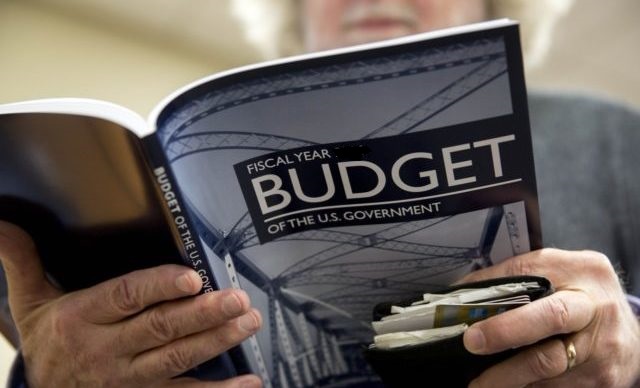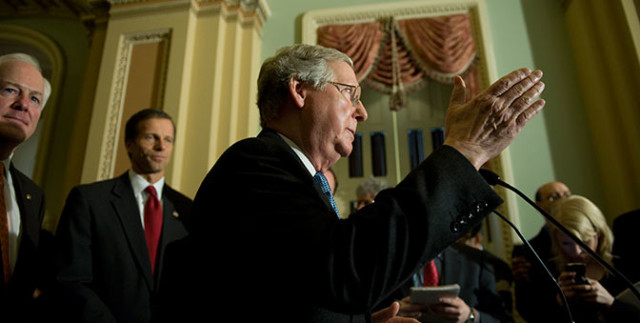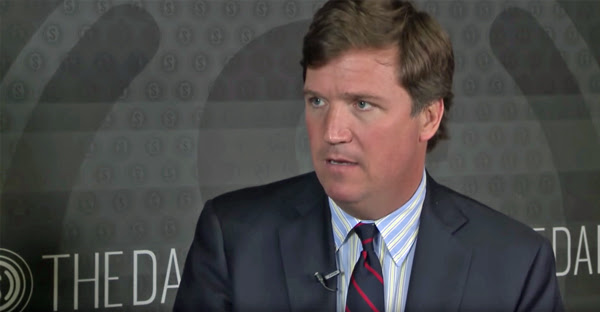
>> Note: This live blog no longer is being updated by Heritage Foundation policy experts.
President Donald Trump’s proposed budget for fiscal year 2021 would reduce the size and reach of the federal bureaucracy significantly by shifting government responsibilities back to constitutional priorities and empowering state and local governments.
These reforms, contained in the request Trump sent Monday morning to Congress, would put the budget on track to balance and represent a significant first step toward reducing spending and stabilizing the nation’s unsustainable debt.
However, the president’s proposal represents a missed opportunity in other areas. Namely, it fails to propose significant reforms to Social Security and health care entitlement programs, the main drivers of spending and debt growth.
In these trying times, we must turn to the greatest document in the history of the world to promise freedom and opportunity to its citizens for guidance. Find out more now >>
The president’s annual budget proposal should serve as a road map to Congress for how the executive and legislative branches can work together to increase individual freedom and economic prosperity for all Americans.
Out-of-control federal spending is a threat to that freedom and prosperity. The president must continue to lead the way and propose bolder reforms that not only will balance the budget in the short term but also put the government on a long-term path to sustainability.
Trump’s budget request would:
1. Cut spending by $4.4 trillion and put the federal budget on a path to balance. The president’s budget includes $4.4 trillion in proposed spending cuts. According to the administration, this is the highest number of spending cuts a president ever has proposed.
In a sign of how unsustainable federal spending has become, even with over $4 trillion in cuts the budget does not balance in 10 years.
The proposal does provide a path to balance though, reducing deficits from nearly 5% of gross domestic product to less than 1% of GDP by 2030. The administration projects a surplus by 2035.
With the gross national debt already surpassing the size of the economy, there is no time to waste. The Trump administration should strive to balance the budget within 10 years.
2. Significantly reduce the federal bureaucracy. Over the past century, the size and scope of the federal government has expanded well beyond the constitutional priorities envisioned by the Founding Fathers. The president’s 2021 budget makes significant progress in reducing the government’s reach and returning power to the people.
The budget proposal includes $1.9 trillion in cuts to nondefense discretionary programs. Much of the nondefense discretionary budget includes waste, duplication, or overlap, or funds programs that have no proper federal role.
To address these problems, the president’s budget proposes a 5% cut to nondefense programs, rejecting the irresponsible Bipartisan Budget Act of 2019. The budget proposes a 2% annual cut from 2022 to 2030.
Nondefense discretionary reforms alone won’t balance the budget, but they will help to ensure that the federal government focuses on truly national needs.
3. Prioritize national defense. The president’s budget proposes $740.5 billion in national defense spending, consistent with the level provided by the Bipartisan Budget Act of 2019. This is a $2.5 billion (0.3%) increase compared to 2020.
The budget realizes over $5 billion in savings within the operations of the Department of Defense, which the administration reinvests in higher priorities, such as nuclear modernization, missile defense, and increased readiness.
The security of Americans at home and abroad is perhaps the greatest responsibility of the federal government. Providing appropriated national defense funding should remain a top priority.
What’s Needed in the Budget
To stabilize spending and debt growth, lawmakers must pursue bolder reforms. One area where the president’s budget falls short is in addressing the growth of entitlement spending.
Last month, the Congressional Budget Office projected that annual Medicare, Medicaid, and Social Security spending will nearly double in the next decade, consuming 59% of federal revenues by 2030.
Medicare and Social Security are unsustainable and both are on a path to insolvency. The budget should propose fundamental reforms to these programs that will lower costs and return control over health care and retirement needs to the American people.
This proposal does not achieve that goal, providing only modest reforms to health care programs and Social Security’s disability insurance program. It will be impossible to reduce spending and stabilize debt over the long term without reforming entitlement programs.
President Must Lead Way
Trump’s budget would reshape the federal government and refocus it toward constitutional priorities, significantly reducing spending and balancing the budget in 15 years.
Nevertheless, there is much more work to be done. The nation’s long-term debt trajectory is unsustainable and will negatively impact current and future generations.
The president’s budget provides the groundwork to avert that future; however, he must continue to lead Congress toward bigger and bolder reforms.
In the space below, Heritage Foundation analysts dig into some of the specific aspects of the president’s budget request.
Individual Tax Cuts Extended, Other Pro-Growth Reforms Left Out
Trump’s budget proposal would keep taxes from automatically increasing on working Americans, as is currently scheduled for 2026.
By extending the individual tax cuts from 2017, the budget would cut taxes by $1.4 trillion. Keeping taxes low for individuals is rightly a key priority for a taxpayer-focused budget.
But the budget does not include similar protections for new business investments in American workers, which begin to phase out at the end of 2022.
First, let’s look at the individual protections that the budget would extend. These are the same changes that cut taxes for 9 out of 10 taxpayers in 2018 and had significant benefits for Americans in every income group. The average American got a $1,400 tax cut in 2018, or $2,900 for a family of four.
To keep these benefits from reversing, the budget would retain the federal income tax rates at the lower levels, the larger standard deduction, the doubled child tax credit, and the capped deductions for state and local taxes, among many other important reforms.
For businesses and their employees, the budget would maintain the permanently lower corporate tax rate at 21%, down from the 2017 global high of 35%. This stands in contrast to leading Democrats who want to increase the federal business tax rate as high as 42%—about 10 percentage points higher than any other major country.
Paired with lower rates, the most pro-growth reform of the 2017 tax cuts allowed businesses to write off many new investments immediately. These rules for immediate expensing are left out of the budget proposal.
Without the protections of expensing, it will be more expensive for new businesses to open and for mature businesses to upgrade and expand operations—resulting in fewer jobs and slower wage gains. Making expensing permanent is a crucial component of meeting the Trump administration’s target of 3% growth.
As the administration develops a formal proposal for tax cuts 2.0, reforms such as expensing and universal savings accounts are crucial components.—Adam N. Michel, senior policy analyst, Grover M. Hermann Center for the Federal Budget
A Flat Future for Defense
The Trump defense budget request follows the cap set by the Bipartisan Budget Act of 2019, at $740.5 billion. It would be a 0.3% increase over last year’s appropriated defense budget.
This is not enough to cover inflationary cost growth for the coming year, let alone reach the 3% to 5% annual real growth that Defense Secretary Mark Esper stated was necessary to meet the challenges of the National Defense Strategy just last Thursday.
The budget describes some cuts that were made by the Defense Department as it sought to find savings in accounts such as health care or defense logistics. This effort freed $5 billion that had been reinvested in higher priority items such as our nuclear deterrent and cutting-edge technology research.
Hopefully, Congress will support those changes.
The budget also describes essentially a flat trajectory for defense spending in future years, in marked contrast to what was deemed as necessary by multiple secretaries of defense and by the bipartisan Commission on the National Defense Strategy.
In the budget document, defense raises at inflationary levels from fiscal 2021 to fiscal 2025 and then is literally flat until fiscal 2030. A clear disconnect exists between what senior Pentagon leaders have expressed as necessary and what the White House has outlined.
A flat budget for the Defense Department would mean that every year, the department will have to find around $14 billion of savings in order to maintain its purchasing power. Even in the context of a $740 billion budget, it is going to be a tall task.—Frederico Bartels, policy analyst for defense budgeting, Center for National Defense
Optimistic, but Not Impossible, Economic Projections
Fast economic growth and low interest rates are key assumptions that would help the president’s budget proposal balance in 15 years. These projections are certainly optimistic, but not inconceivable in an aggressively pro-growth policy environment.
The assumed average growth rate of 3% is not comparable to other projections, such as the recently released Congressional Budget Office economic forecast of a 1.7% annual growth rate.
CBO assumes that things stay on their current trajectory, taxes increase in 2025, deregulation efforts stop, and federal programs keep growing out of control. The president’s budget assumes many of the opposite policies, and thus can count on better economic conditions.
The assumed growth rates are certainly close to the upper bound of pro-growth optimism, but also represent a simple return to historical trends. Sustained high growth does not follow automatically from enacting the president’s agenda. Many other things outside the control of Washington also must go right.
Economic growth of 3% would be easier to achieve if the budget also included a concrete path to reduce tariffs, quiet trade uncertainty, and extend the business expensing tax reforms set to expire at the end of fiscal 2022.—Adam N. Michel, senior policy analyst, Hermann Center for the Federal Budget
Government Shouldn’t Run Paid Family Leave
The president’s budget calls for more government intervention in paid family leave, extending paid parental leave benefits to all new parents.
The mechanism appears to be small grants to states to help them set up programs that work best for their workforce and economy, but state-level politicians and bureaucrats still are not better equipped than business owners and workers to know what works best for them.
It turns out that employees value flexible work schedules by a margin of 6-to-1 over more paid parental leave. Including other means of granting more flexibility to workers, such as through telecommuting, increases the ratio to 11-to-1.
Although paid parental and paid family leave are valuable, they are not without cost and consequence. Some of those costs and consequences are playing out with existing state-based programs of paid family leave.
Both California’s and New Jersey’s programs increased the unemployment rate and the duration of unemployment for young women. And in California, the program resulted in 7% lower employment and 8% lower annual earnings for mothers, as well as reduced fertility rates.
These programs also are regressive, taxing everyone but primarily benefiting middle- and upper-income earners. In California, workers in the highest income bracket file more than five times as many paid family leave claims as those in the lowest-income bracket.
And although the taxes may start out low, they already have grown and will continue to grow over time. Economists estimate that a national paid family leave program would cost the average worker an extra $1,500 to $2,900 per year in additional taxes.
With tremendous growth in the number of new and expanded employer-provided policies, now is not the time to sideswipe more flexible and accommodating policies with one-size-fits-all, rigid, and bureaucratic government programs.
Most workers and families would prefer to be able to choose how to spend their money in ways that meet their particular needs than to have it taken from them and be told what types of government programs they are eligible to receive. It turns out that although paid parental leave is important to employees, there are better ways to help them balance work, family, and health needs.
The Working Families Flexibility Act would give lower-wage workers the option to accumulate paid time off; universal savings accounts would help families save for all kinds of life events; and fewer regulations would free up business resources to help employers provide paid family leave.
None of these would subject workers and their families to the mercy of government programs and bureaucrats to meet their needs.—Rachel Greszler, research fellow in economics, budget, and entitlements, Hermann Center for the Federal Budget
Education Spending Smartly Trimmed; Tax Credit Scholarship Remains Pitfall
The Trump administration has requested $66.6 billion for the Department of Education, which would be a 7.8% (or $5.6 billion) reduction from the $72.2 billion enacted for fiscal 2020.
Although the proposed reductions are slightly lower than those proposed last year, the top line for the agency goes in the right direction. And overall, the budget would save $124 billion over 10 years through reductions in mandatory program spending at the department.
Moving in the right direction. In the K-12 space, the budget would establish the Elementary and Secondary Education for the Disadvantaged Block Grant, consolidating 29 existing programs into a single $19.4 billion formula-funded block grant.
The budget includes few details about the proposed block grant, but the funds would be distributed through the existing Title I formula; states and school districts then could “decide how best to use” funds.. This approach appears to mirror that of the Academic Partnerships Lead Us to Success (APLUS) Act, a longstanding goal of conservatives.
The APLUS proposal, introduced by Rep. Mark Walker, R-N.C., and Sen. Steve Daines, R-Mont., would allow states to opt out of the existing, labyrinthine structure of Elementary and Secondary Education Act programs, and put their federal K-12 dollars toward any lawful education purpose under state law.
The budget wisely calls for elimination of subsidized student loans (saving $18 billion from 2021 to 2030), along with the elimination of Obama-era public service loan forgiveness (saving $52 billion from 2021 to 2030). It also would cap the Graduate PLUS loan program, saving $27.5 billion over 10 years, as well as the Parent PLUS loan program.
The administration wisely would eliminate Public Service Loan Forgiveness—which passes the tab for public employees’ student loans onto taxpayers after 10 years. But is also would reduce from 20 years to 15 years the length of repayment for undergraduate students under the proposed Income Driven Repayment plan—a step in the wrong direction.
Profligate federal spending through subsidized student loans has fueled tuition inflation, driving up college costs and burdening families. Student loan forgiveness policies have exposed taxpayers to $1.6 trillion in outstanding student loan debt.
This budget recognizes those realities and makes some important course corrections in the right direction. But it should go further in ensuring that no taxpayer should have to pay for someone else’s loan that they didn’t agree to take out.
Policy shortfalls. Although there is much to celebrate in the president’s budget request, one major misstep is the proposed $5 billion Education Freedom Scholarships program, which would cost $45 billion from 2021 through 2030.
This new program would leverage the federal tax code to create a scholarship program for eligible students to attend a private school of choice. As my colleague Adam Michel and I recently wrote:
The administration’s support of school choice is praiseworthy, but a federal tax credit scholarship program poses a threat to education choice in the states, and undermines the goal of a streamlined federal tax code.
Moreover, the federal government does not have the constitutional authority to create such a program, which would establish massive new federal spending and would likely subject private schools to future regulations from an administration and Congress less friendly to education choice.
The budget also includes significant new spending in another area reserved to the states: vocational education. Although career and technical education is an important tool for climbing the ladder of upward economic mobility and pursuing careers in the trades, it is the job of local high schools to provide for vocational classes, not the federal government.
Yet the proposed budget would increase spending by nearly $1 billion on career and technical education “to help ensure that every high school has a high-quality vocational program.” This is despite the fact that 98% of public school districts already offer career and technical education to high schools students.
Finally, over at the Department of Health and Human Services, funding for the failed Head Start program is maintained, and the budget proposes a new $1 billion “investment for states to build the supply of care and stimulate employer investment is child care.” It is long past time for Congress and the administration to restore revenue responsibility for Head Start to the states.—Lindsey M. Burke, director, Center for Education Policy and Will Skillman fellow in education policy
A Critical Reform to School Meals
The budget proposal would fix an egregious and likely unauthorized expansion of school meals to middle-class and wealthy families.
Nearly a century ago, federal lawmakers created the National School Lunch Program to help children in need who couldn’t afford to buy food at school. Yet in 2010, Congress expanded eligibility for school meals through the Community Eligibility Provision, allowing some schools and districts to provide free meals to students from middle-class and wealthy families.
As if this weren’t bad enough, the Department of Agriculture then improperly interpreted the provision to allow even more schools to provide free meals to children who are not in need.
The Community Eligibility Provision allows schools or districts to offer “free” meals to all students if 40% or more of the students in the school or district are eligible for means-tested welfare programs such as food stamps.
The Agriculture Department has gone beyond the scope of the law and is allowing districts to group schools together in order to meet this 40% threshold. As a result, a district could group a school that doesn’t enroll a single student from a low-income family with another school that does have a high percentage of children living in poverty. If together these two schools meet the 40% threshold, the school without a single low-income student can provide free meals to all of its students.
The budget proposal clarifies that districts cannot group schools together in this way. Each school would have to meet the 40% figure to participate in the Community Eligibility Provision.
If this change is made, children in need would still be able to access free and reduced-priced meals, but the federal government will begin the process of returning these school meals to the original purpose: helping children from low-income families.—Jonathan Butcher, senior policy analyst, Center for Education Policy, and Daren Bakst, senior research fellow in agricultural policy, Thomas A. Roe Institute for Economic Policy Studies
Protecting Private Union Pensions Without Taxpayer Dollars
The president’s budget once again calls for protecting workers with multiemployer—or union—pensions by keeping the government entity that provides pension insurance, the Pension Benefit Guaranty Corporation, solvent for at least the next 20 years.
The PBGC’s multiemployer program it expected to run out of funds to pay insured benefits in just five years, at which point workers could receive mere pennies on the dollar in promised benefits.
At stake is a massive $638 billion shortfall between what private sector employers and unions promised to their workers and what they actually set aside to pay them. Of the roughly 11 million workers with multiemployer pensions, more than 75% are in plans that are less than 50% funded.
The Pension Benefit Guaranty Corporation provides a backstop to pension losses, but its revenues are nowhere near sufficient to provided needed benefits.
The president’s fiscal 2021 budget calls for an additional $26 billion in the PBGC’s multiemployer program premiums, including adding a risk-based component to discourage plans from overpromising and underfunding.
Notably, this is an $8 billion increase from last year’s proposed $18 billion increase to accomplish the same goal of keeping the PBGC solvent for another 20 years. That increase came despite Congress’s unprecedented bailout for the United Mine Workers of America’s $6 billion in broken pension promises, a large portion of which otherwise would have been the PBGC’s liability.
This dramatic one-year increase emphasizes the high price of failing to enact commonsense multiemployer pension reforms. The longer congress waits, the higher the risks of another taxpayer bailout become.—Rachel Greszler, research fellow in economics, budget and entitlements, Hermann Center for the Federal Budget
Reforming Agricultural Subsidies
Once again, the Trump administration should be commended for trying to bring commonsense reform to agricultural subsidies.
The budget request explains: “The budget proposes to maintain a strong safety net for farmers while achieving savings by: eliminating subsidies to higher-income farmers; reducing overly generous crop insurance subsidies to producers and companies; and eliminating some programs that have no federal purpose or are duplicative.”
Proposed reforms include:
—Limiting the crop insurance premium subsidy for farmers to a reasonable and more defensible number. Currently, taxpayers pay on average 62% of the federal crop insurance premiums for farmers. The budget would maintain a very generous subsidy, but reduce it so that taxpayers would on average pay 48% of premiums. Congress should embrace this widely supported bipartisan reform.
The Government Accountability Office has recommended this reform and the Congressional Budget Office listed reducing premium subsidies as one of its options to reduce the deficit. (The CBO option would be more ambitious, lowering the subsidy to 40%). This change would save about $21 billion over 10 years.
—Limiting specific subsidies to agricultural producers with an adjusted gross income of less than $500,000. This change still would allow subsidies to go to producers who are doing very well financially (as measured by adjusted gross income), but would bring some limits to the federal government’s generosity with taxpayers’ money.
As explained in the budget:
The budget proposes to eliminate premium subsidies, commodity payments, and conservation program eligibility for farmers with AGIs [adjusted gross incomes] over $500,000. It is hard to justify to taxpayers why the government should provide assistance to farmers with incomes over half a million dollars. Doing so undermines the credibility and purpose of farm programs. In 2013 (a year of record-high farm income), only 2.1% of farmers had AGIs in excess of this amount.
Additional reforms in the budget proposal include tightening payments limits, eliminating loopholes, and ending excessive assistance to crop insurance companies.—Daren Bakst, senior research fellow in agricultural policy, Roe Institute for Economic Policy Studies
Preserving the Health Care Safety Net
The president’s budget highlights the need to preserve and protect the health are safety net for those who need it. The Medicaid program, which serves the most vulnerable in our society, is overstretched and overburdened.
Right now, 1 in 5 Americans use Medicaid, and federal and state spending on the program is nearing a trillion dollars. This creates significant pressure on federal and state budgets, squeezes other important priorities, and leaves those on the program at risk.
The budget builds upon current administrative actions and lays out additional reforms for the Medicaid program. Specifically, it highlights new efforts to provide states with additional flexibility to care for those with mental illness, recommends new measures to ensure only those eligible for the program are enrolled, and extends welfare work requirements to the Medicaid program to continue to help Americans move up and out of poverty.
These policies are headed in the right direction. The budget recognizes the importance of instituting changes that will improve the management and oversight of the program. It also recognizes, through its broader health reform vision, that more should be done to meet the needs of those who need it most.—Nina Owcharenko Schaefer, senior research fellow, Health Policy Center
Reducing the Cost of Prescription Drugs
The president’s budget rightly calls on Congress to address high prescription drug costs. Government policy contributed to this problem through flawed regulations and subsidies that drive up costs.
The budget would address these flawed policies by supporting bipartisan congressional reforms to the successful Medicare prescription drug benefit. The Heritage Foundation has outlined a road map with details of such reforms, which would provide relief for patients and taxpayers.
At the same time, policymakers must reject heavy-handed solutions, such as those proposed by House Speaker Nancy Pelosi, because they would limit access to lifesaving medicines and impede access to new cures.
Lawmakers should focus on addressing the underlying problems in public programs rather than layering on additional administrative and regulatory schemes such as international reference pricing.—Edmund F. Haislmaier, Preston A. Wells Jr. senior research fellow in domestic policy studies
Strengthening the Medicare Program
The president’s budget will strengthen Medicare by providing for a more rational payment system, improving choices and care options for America’s seniors, and combating the waste, fraud, and abuse that has historically plagued the program.
Trump is proposing to change the way Medicare pays for medical benefits services and procedures. Currently, Medicare reimburses medical services performed at hospitals at a higher rate than the rate paid to physicians or clinics providing medical services outside of the hospital setting. Under the president’s proposal, the Medicare payment for several procedures or services would be the same regardless of the setting of the care delivery.
Long championed by The Heritage Foundation, this change to the “site neutrality” payment system not only would reduce excessive costs but also create a level playing field between hospitals and other care delivery systems. This would strengthen competition and increase physician independence while expanding choices and lowering costs for Medicare patients.
From 2021 to 2030, these site neutrality proposals—for post-acute care, hospice care and care in physician offices—are projected to save an estimated total of $270.3 billion.
With these and other Medicare payment adjustments, the administration estimates that the total set of Medicare changes would extend the life of the Medicare hospitalization trust fund for the next 25 years. Under current law, the Medicare hospitalization trust fund faces insolvency in 2026.
The president’s budget also includes several proposals to expand the choices of Medicare patients. The proposed budget would allow Medicare beneficiaries with high-deductible health plans the right to make tax-free contributions to health savings accounts and medical savings accounts.
In accord with another longstanding Heritage Foundation policy recommendation, the president’s budget also would allow Medicare beneficiaries the right to choose a comprehensive private health plan, if they wish to do so instead of enrolling in the Medicare hospitalization program (Part A), without losing their Social Security benefits.
Moreover, in an effort to strengthen cancer screening, Trump’s budget would end coinsurance requirements for Medicare patients who undergo colonoscopies with polyp removal.
The president’s budget also includes initiatives that he offered last year, including significant reforms of graduate medical education and uncompensated hospital care payments. To beef up the administration’s continuing campaign to combat waste, fraud, and abuse in the Medicare program, the budget would provide an additional $13.7 billion to that effort over 10 years.—Robert E. Moffit, senior fellow, Health Policy Center
Shrinking Energy Cronyism, Unleashing Energy Abundance
Similar to the Trump administration’s previous budgets, the proposal for fiscal 2021 would shrink the federal government’s unnecessary meddling in energy markets.
The president’s budget also proposes to repeal special tax credits for renewable energy technologies, which eliminate a major source of government favoritism in energy markets and relieve taxpayers of a $16 billion burden over 10 years.
The budget also would eliminate energy loan programs—in particular the Title XVII loan guarantees for “advanced technologies” and the Advanced Technology Vehicles Manufacturing loans. These programs put taxpayers’ money at risk, leading to notorious bankruptcies such as Solyndra, and the current underwriting of the multibillion-dollar Vogtle nuclear reactors in Georgia. These programs distort risk and private-sector investments, not to mention that the government shouldn’t be an investor in energy projects anyway.
The budget also would reduce spending in applied research and development energy programs. Whether it’s basic or applied, taxpayers shouldn’t foot the bill for activities best left to innovators and private investors.
In contrast to some calls to nationalize more of the energy sector, the president’s proposal would sell off transmission assets of the Power Marketing Administrations—four quasi-federal electric utilities serving the South and West. It also would reduce their access to taxpayer-subsidized borrowing authority and require them to sell power at market rates.
These are good stepping stones to privatizing these assets—something the Reagan and Clinton administrations both recommended and was done successfully under Bill Clinton with the Alaska Power Administration.
Importantly, the Trump administration would continue to right- size burdensome regulations that have tied up energy development in years of red tape. As the president’s budget emphasizes:
Energy companies across the world are ready to build in our nation, and permitting reform that cuts red tape shows that we welcome their investments. My administration continues to support growth in the energy sector by removing unnecessary regulations and unleashing America’s vast natural and human resources.
The administration’s commitment to open access to America’s wealth of energy on federal lands is a welcome reversal from the previous administration’s “keep it in the ground” mentality.— Katie Tubb, senior policy analyst for energy and environmental issues, Roe Institute for Economic Policy Studies, and Nicolas Loris, deputy director, Roe Institute for Economic Policy Studies and Herbert and Joyce Morgan research fellow
Yucca Mountain: Complicated Invitation to Reopen Debate
Up to now, Trump’s budgets have requested just enough funds to finish the licensing review of a repository for nuclear waste at Yucca Mountain in Tonopah, Nevada.
But for 10 years, Congress has failed to either to pass legislation or appropriate funds so the administration could follow the Nuclear Waste Policy Act, which designates Yucca Mountain as a national repository.
This negligence has cost constituents $8 billion in lawsuits already—exactly what the law was designed to prevent—and is on track to cost tens of billions more in the years to come.
So, the president’s frustration is deeply merited.
Unfortunately, the administration’s budget request does not include funds to finish the license review of a potential repository at Yucca Mountain. Instead, it proposes $27.5 million to begin an “Interim Storage and Nuclear Waste Fund Oversight” program.
Importantly, the administration cannot strike out on its own to develop new policy; the Nuclear Waste Policy Act is quite clear that the administration cannot pursue an interim storage program without progressing on a permanent waste repository. The courts swatted down the previous administration’s attempt to disregard the law unless and until Congress changed it.
Finishing the Yucca Mountain review is a relatively small step that would inform decisions, no matter what long-term nuclear waste disposal options ultimately are pursued. It does not inescapably commit Congress to building the repository without further appropriations—something Congress has been quite adept at withholding.
It also would let the voices of all Nevadans be heard. Most of the state’s congressional delegation opposes a Yucca Mountain repository. But funding completion of the review, and review only, is consistent with their demands for a thorough process with state input, and for further adjudicating concerns in a formal setting that the Department of Energy must address.
Despite this noticeable absence, the budget proposal also assumes the nuclear waste fee—an arbitrary fee on nuclear power plants set by the Department of Energy—will be reinstated in fiscal 2023. But this fee is one of the deep, fundamental flaws plaguing nuclear waste management policy that need to be reformed.
Trump is right to want to look for solutions, and his budget provides an opportunity to reopen the conversation. Nuclear waste management policy and the roles of industry, states, and the federal government need to be reimagined. The first step is finishing the review of Yucca Mountain.
Ultimately, a real solution comes from giving the nuclear industry responsibility and introducing market forces into waste management solutions.—Katie Tubb, senior policy analyst for energy and environmental issues, Roe Institute for Economic Policy Studies
Wrong Way on Transportation
The president’s budget envisions a significant increase in federal spending on infrastructure, proposing $1 trillion in funding over 10 years. This is the wrong way to improve the nation’s roads, bridges, and other valuable physical assets.
Federal involvement makes infrastructure projects more expensive, more time consuming, and more vulnerable to political manipulation.
For example, federal spending on mass transit far exceeds its actual use by Americans when compared to highways. However, congressional Democrats historically have demanded that transit receive a too-generous amount of funding as a percent of overall transportation spending. Trump’s budget does nothing to meaningfully change this politically driven calculation.
Although the administration has made progress on regulatory reform such as the “One Federal Decision” rule and streamlining the National Environmental Policy Act, this does not change the fact that the federal government is a cumbersome and inefficient partner for infrastructure projects.
Red tape such as the Davis-Bacon Act and project labor agreements drive up costs by forcing state government contractors to pay union wage rates and use union-style work rules. The process of submitting proposals for federal subsidies delays the start of projects that normally should be the sole responsibility of state and local governments.
Just as important, more federal activity would crowd out private infrastructure activity. Private financing avoids many wasteful federal regulations and reduces the burden on taxpayers.
It is vital to understand that there are only two ways to pay for spending increases: more taxes or more debt. The president’s budget does not call for a gas tax increase or a new transportation revenue source, which means that the infrastructure proposal reduces the amount of deficit reduction in the budget.
Rather than increasing the federal infrastructure role, Congress and the administration should go the opposite direction. A policy of reducing the federal gas tax, lowering infrastructure spending, and further eliminating red tape would enable more activity and value from state and local governments and the private sector, enhancing America’s prosperity.—David Ditch, research associate, Hermann Center for the Federal Budget
Waste Cut in Higher Education, but New Repayment Options Leave Taxpayers on Hook
The president’s budget takes meaningful steps in reducing or eliminating wasteful spending on higher education. Most notably, changes to the federal student loan program such as eliminating Public Service Loan Forgiveness, ending subsidized loans, and placing caps on both the Parent and Graduate PLUS loan programs meaningfully insulate taxpayers from risky loans made by the Department of Education.
The president’s budget also calls for consolidation of loan repayment plans into one income-driven repayment plan. Although the overly complicated federal student loan repayment options are badly in need of simplification, the budget proposes reducing the number of years a student must pay off their loans from 20 years to 15 years for undergraduate students. The remaining balance after that time would be “forgiven” and absorbed by taxpayers.
This moves federal policy in the wrong direction. Instead, the budget should prioritize insulating taxpayers from the financial risk for students who are unable to pay off loans.
However, the budget’s constraints on duplicative or ineffective higher education programs is praiseworthy. The budget puts guardrails in place to reduce improper payments in the Pell Grant program. Additionally, it calls for eliminating the redundant Federal Supplemental Education Opportunity Grants, as well as reducing funding for the federal TRIO and work-study programs.
Such programs have little evidence of success, at significant cost to American taxpayers.—Mary Clare Amselem, policy analyst, Center for Education Policy
Defending Free Speech on Campus
The administration’s budget proposal draws national attention to the repeated shout-downs, disinvitations, and other forms of censorship on college campuses.
The proposal says that colleges that receive federal research grants “must adhere to the requirements of the First Amendment to the Constitution,” a reminder for schools that allow students to shout down invited lecturers or chase the college president off a stage that such actions interfere with and may even violate individuals’ freedom to listen and be heard.
Last year, the president raised the profile of this issue with a broadly worded executive order. Similar to the language in the budget proposal, the order said colleges that receive federal grants should “promote free inquiry” and enforce the First Amendment.
Although both the budget and the executive order appropriately emphasize that disruptive protests threaten expressive rights on campuses around the country, Washington should be careful with any additional actions. The Department of Education should not enlarge the federal footprint in higher education by assuming new investigative responsibilities.
Generally, state policymakers and university governing boards are responsible for public university systems. Policymakers around the country are taking action to protect speech when college administrators fail to do so.
State officials in Alabama, Arizona, Georgia, North Carolina, and Wisconsin have adopted provisions that reinforce the rights of anyone lawfully present on a public college campus. The provisions are based on the idea that individuals and groups should be allowed to protest or demonstrate in publicly accessible areas (such as on sidewalks or lawns).
Furthermore, public university leaders should be prepared to impose consequences on individuals—including students—who violate someone else’s right to speak while closely adhering to due process protections for the accused. Such policies already are having their intended effect: In Wisconsin, one group of protesters said the university’s new policies prevented them from shouting down a speaker in 2017.
The Justice Department should continue to defend free speech on campus through statements of interest in appropriate cases. In 2018, after the group Speech First filed a suit against the University of Michigan over the school’s so-called Bias Response Team, the department issued a statement saying the university’s policy “chills protected speech.” The U.S. Court of Appeals for the 6th Circuit issued a ruling with a similar statement, and the school settled with Speech First and revised its policies.
The White House should emphasize that public colleges must protect the First Amendment, but officials should beware of the potential for unintended consequences from federal administrative actions. State policymakers should guard expressive rights on campus and direct public college governing boards to adopt proposals that do the same.—Jonathan Butcher, senior policy analyst, Center for Education Policy
A Note for our Readers:
This is a critical year in the history of our country. With the country polarized and divided on a number of issues and with roughly half of the country clamoring for increased government control—over health care, socialism, increased regulations, and open borders—we must turn to America’s founding for the answers on how best to proceed into the future.
The Heritage Foundation has compiled input from more than 100 constitutional scholars and legal experts into the country’s most thorough and compelling review of the freedoms promised to us within the United States Constitution into a free digital guide called Heritage’s Guide to the Constitution.
They’re making this guide available to all readers of The Daily Signal for free today!
EDITORS NOTE: This Daily Signal column is republished with permission. © All rights reserved.









